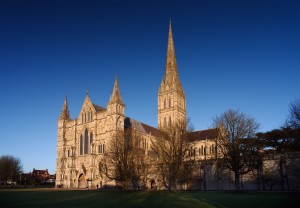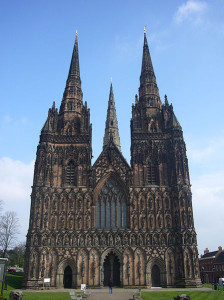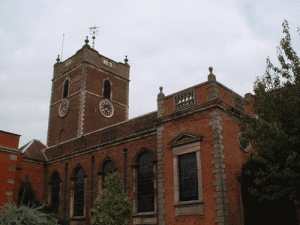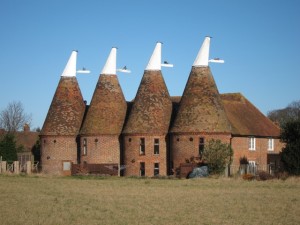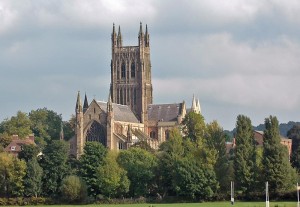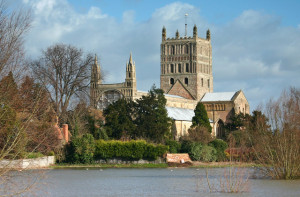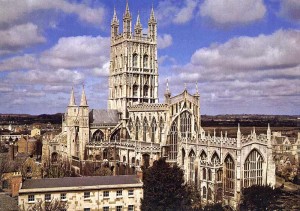Creating the Francis Asbury pictorial journey would involve a work that spans both sides of the Atlantic Ocean. However, for this article, only the significant locations in England will be detailed. For the American locations, a separate article will be made in the future.
The idea of the Francis Asbury pictorial journey is inspired by English artist John Hurst’s book, John Wesley: A Pictorial Journey. John Hurst’s collection of beautiful watercolor paintings depict strategic locations of John Wesley’s travels in England and Ireland.
It was an honor of this author when Mr. Hurst decided to paint the front cover of the book, Black Country. In John Hurst’s pictorial work of John Wesley, his rendering of the interior of the New Room at Bristol is one of my favorites. For more of John Hurst’s fine work, please visit his website.
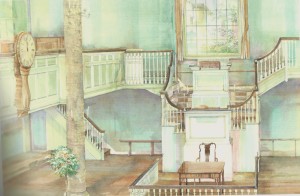
John Hurst’s Interior New Room Bristol
The Francis Asbury pictorial journey would without question begin where his preaching started, in the West-Midlands of England. John Hurst’s capture of the Asbury cottage in Great Barr is a fabulous painting. The red-brick structure, with its second-level dormer windows facing to the west, is an inviting work. The upper windows of the home seem to give the young Francis Asbury a clear view in the direction of his eventual calling to America. The home of Joseph and Elizabeth Asbury was also the location of prayer gatherings for more than 50 years.
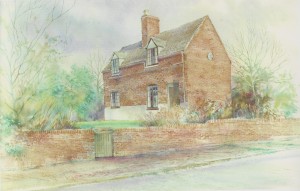
John Hurst painting of Francis Asbury Cottage in Great Barr, Staffordshire
All Saints Church in West Bromwich is another stop on the Francis Asbury pictorial journey. It is the church where Francis Asbury first experienced the movement started by John Wesley.
All Saints is a church built in the Norman style. It is said to have existed since 1100 A.D. Old Church, as it is known to the residents of West Bromwich, is the central location of the West Bromwich group of Methodists, a satellite gathering of the much larger Wednesbury group. Fortunately, for the Bromwich and Wednesbury worshipers, the vicar of All Saints, Edward Stillingfleet, has gained the confidence of the local family of nobility, the Legge family.
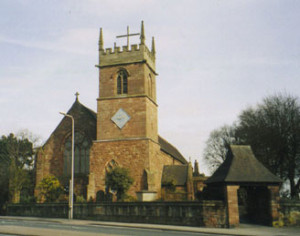
All Saints Church
West Bromwich
William Legge, the Earl of Dartmouth during the time of Francis Asbury, is the grandson of the first Earl of Dartmouth. The grandson William secured Edward Stillingfleet for the All Saints church. Edward is an Anglican Priest who is sympathetic to the Methodist cause. Brother Dartmouth, as he insists to be called, is also a devoted Methodist and member of the Wednesbury Methodist Society. William and Edward are both friends of Selina, the Countess of Huntingdon. Through Lady Huntingdon, Vicar Stillingfleet has been able to secure the most notable itinerants of the Wesleyan movement, men like Henry Venn.
Another landmark in the Francis Asbury pictorial journey is a cathedral which he views on one of his first itinerant journeys. The trip occurred when Francis Asbury was a local lay leader when asked by John Wesley’s Scottish itinerant, Alexander Mather, to join him on a journey to Ashbourne in Derbyshire. Along the way, one of the first landmarks on this Francis Asbury pictorial journey is the magnificent three-spired cathedral in Lichfield. The Lichfield Cathedral structure dates to the year 669 AD when it was built as a tribute to the one thousand Christian martyrs who met with sudden death at the hand of the fourth-century Roman emperor, Diocletian.
The revised architecture of the building that greets Francis took its shape in the early portion of the eleventh century. Some have attributed the name Lichfield to the killings of the followers of Christ, the Saxon word lych meaning a dead body. However, the name is also associated with the alternate Saxon meaning of the word, a marsh or morass. Two low-lying bogs surround the town of Lichfield; the town’s residents call them moggs. The two sloughs connect two lakes that lie adjacent to the cathedral, Minister Pool and Stow Pool. Lichfield Cathedral before the Reformation of the sixteenth century was a magnificent display of architectural wonder. Towering displays of stained glass and ascending buttresses of the red sandstone color delivered the welcoming eye to the three spires reaching toward heaven. Lichfield Cathedral is the only medieval English cathedral constructed with three spires. The distinct coloration of the building, the magnificent architecture, and the immense size of the structure are designed to focus hearts on the awesomeness of the Creator.
In the city of Stourbridge the next stop on the Francis Asbury pictorial journey is St. Thomas Church. In the book, Black Country, Francis Asbury departs West Bromwich heading toward the nailing village of Stourbridge. One constant for Francis on this eight-mile journey is the rolling hills that consistently grow larger on the horizon. Looking toward the lush hills on the western border toward Stourbridge, the first signs that summer has departed cover the fields, the amber spires of ornamental grasses blanketing the meadows as they swell in every direction. Approaching the little town of Stourbridge, Francis begins to hear a beautiful sound. The melodic petition is enjoyable to the itinerant. He slows his horse, Churchfield, and the two pause to listen to the peals of bells, those beautiful, musical bells, Francis cannot help but think of them as they ring across the knolls and hillocks.
“Can you hear it Churchy?”
Churchfield, grunts as he busies himself with the meadow’s natural fodder.
“Come Churchy, we shall investigate.”
Prompting the reigns and poking Churchfield, the horse ends his short-term feast, raises his head and begins again. The sound grows louder as they approach the village. Francis is pleased that the music has remained for nearly five minutes. The bells continue. In the distance, Francis spots the source of the alloyed symphony, a large red-bricked structure, a church. Attached to the building is a tower, nearly 100 foot tall. Atop the bricked, square steeple are the bells. Francis decides to stop.
For the next twenty miles of the Francis Asbury pictorial journey, the young itinerant proceeds through randomly strewn oak-wood forests, rolling fields and tiny hamlets, each consisting of one or two thatch-roofed houses. The numerous hills along the route will eventually result in a 200-foot drop to the destination of Worcester. However, the journey is deceiving, although resulting in a net decline, there are several instances where Francis and Churchfield will once again climb as much if not more height than previously descended. The process repeats itself several times before achieving the final descent into Worcester.
The town of Worcester has its origins with the Roman reign of Constantine. It is uncertain which Constantine, the son of Constantine the Great, Julius Constantine, or Constantine Chlorus, the father of Constantine the Great. Regardless, the city is one of several strategically important Roman settlements located along the River Severn, the center hub for many Roman military roads. One of which, Francis is traveling on from Stourbridge. Worcester is a walled city. For ease in commerce, only one of the ancient entrance gates remains. The ancient roads affiliated with the town form strategic, direct routes connecting London to Wales, the Midlands to the port town of Gloucester, as well as venturing to the northeast, connecting Worcester to Derby. Travelers from the nation and beyond regularly visit this city of commerce with 10,000 residents.
Arriving to town, Francis Asbury finds a mix of open fields splattered among rows of houses, each simple brick structure usually with a thatched roof. Strangely, Francis encounters several houses with a cone-shaped roof. Atop the roof which emits smoke, a funnel-like turret bends at a slight angle. The heated air prompts a thought, whatever for; Francis hasn’t a clue. It is an unfamiliar architectural feature, surely needing to reside in the Francis Asbury pictorial journey. Continuing along, an opening in a stone wall marks where a large gate used to reside. In fact, the metal gates which are each more than 10 feet wide lay aside the doorway which escorts Francis further into the settlement. Francis surmises these must account for the ancient Roman walls of which father spoke.
He is correct. From the first Century until the 17th Century, the Worcester residents raised several sets of barrier walls in order to protect themselves from invading forces. The Roman, Anglo-Saxon and the Norman empires each contributed to the building of the walls. Each new protective boundary uniquely expanded the territory of the town. Francis will pass through several sets of these as he heads in the southerly direction. For the last 50 years, the locals systematically eliminated the imposing gate and columned structures associated with the entrances. Only one gate remains. In fact, several sections of the walls which have not been necessary since the English Civil War almost 120 years before have become valuable real estate as perimeter walls for new development.
Off in the distance, the Worcester Cathedral stands near the edge of the Severn. Francis Asbury once again is disappointed to find a fractured church building. Portions of the grand structure damaged in the English Civil War, appear to list, aching for restoration. As Francis views the afflicted areas, he remembers his conversation with Pastor Mather. Mather’s words are nearly audible, ‘unity requires truth.’ He thinks of the English Civil War and Cromwell’s attacking forces. He also thinks of the Reformation. The recollection causes him to ponder Martin Luther and his 16th Century attempts to repair in lieu of separate from the Catholic Church.
The Severn River is the longest river in England. The source of the waterway is in the Plynlimon Hills, the highest point of the Cambrian Mountains in Wales. Each year, the soggy moorlands receive almost the entire reservoir of the depressions coming off the Irish Sea, (St. George Channel), the powerful Atlantic storms dropping massive amounts of rain. The sponge-like, moss-covered plateau soaks in the precipitation to a point of saturation, forcing the excess liquid to run downhill toward England.
The route along the river is scenic. The late summer/early autumn grasses blanket each side of the river’s shoreline. The purple and pinkish spiny flower heads of the Teasel plants are beginning their annual fade, aiming for the attractive tan color cherished for cut-flower arrangements. The waterway is swift, meandering several s-turns and oxbow lakes through the countryside. It’s erosive flow creating high-walled cliffs on the faster outer edge of the channel and a gentle-shallow slope on the slower inside edge. The long-term effects of such an arrangement creating a constant winding path through the flatter lands of its path.
As Francis travels in a southeasterly direction from Worcester, he notices a stunning view in the distance. Francis guesses that the distant mountain range is the Gloucester and Evesham Vales mentioned by his father. Francis has never traveled through mountains, he fascinates in the fact that if he ventures a little to the east of his current destination, he could try this new experience. He reconsiders, remembering the words of Mather, ‘I shall not put your itinerancy at risk.’ Francis decides to maintain his course, continuing his riverside trek. Periodically though, he finds himself raising his view as he draws toward the magnetic scenery in the distance.
Approaching a small hill, Francis and Churchfield climb towards the building at the top of the mound. The rocky ground gives challenge to the pair. Several times, the horse stumbles, however, the strong animal presses on.
At the top, Francis is pleased to find a downhill view into the town of his destination. In the distance, the next stop in the Francis Asbury pictorial journey resides, the Gloucester and Evesham Vales form a spectacular backdrop to the little village of Tewkesbury. Francis turns his look to the southwest. All is as expected, rolling hills descending toward the town, scattered fields for grazing- Francis Asbury brings his search to a halt.
Turning his view back to an almost southerly position, Francis amazes at the sight. In the distance, on the edge of the town sits a massive stone church. Francis remembers what his father told him, ‘Tewkesbury is an ancient town, the Benedictine Monks established an Abbey there in the year 1102.’ Taking 19 years to complete, the structure had several additions over the centuries. As Francis stares in the direction of the intersection of the River Severn and the Avon River, the magnificent Romanesque tower of the Abbey continues to steal his attention. Yes, he needs to cross the Avon; however, the sight of the Tewkesbury Abbey in the distance causes him to pause.
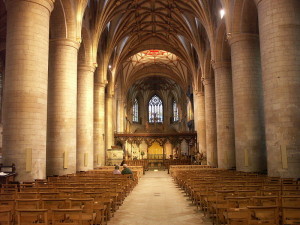
Tewkesbury Abbey
Interior Image
Inside the magnificent church, Francis awes at the height of the ceiling. The impact is more dramatic due to the immense length of the church. Francis guesses that the building is over 300 feet in length. The Abbey’s floor plan is cruciform, in the shape of the Latin cross. Francis surmises the perpendicular cross section is at least 200 feet in length.
Looking upward, the view is imposing. The elevated vaulted arched ceilings reach to more than six stories in height. Each arch originates from a massive circular stone column nearly four stories tall, starting from a corbel-styled head figure and launching upward from there. Nine of the 6’ diameter cylindrical columns line each side of the 33’ wide center nave. Francis stands silent alongside his four-legged companion which sits with mouth closed as if to honor the sacred space.
If the splendor of the Abbey in Tewkesbury is not enough, an additional treasure along the Francis Asbury pictorial journey is Francis’s discovery at the Abbey of famed English poet, John Milton’s organ which Milton himself played.
Next stop on the Francis Asbury pictorial journey is the Gloucester Cathedral.
Gloucester is a port town. Residing on the River Severn, the south-western settlement established by the Roman Empire is a cathedral village. The 11th Century King William I, (William the Conqueror), commissions his chaplain, an outgoing and enterprising monk, Serlo, from Mont St. Michel in Normandy to raise funds to construct a cathedral. Over the next 17 years, the dedicated Serlo accomplishes his goal, allowing for the start of construction in the year 1089. For the next 550 years, the Abbey of St. Peter is the center of Christianity in the city by the river.
The dissolution of the Catholic monasteries by King Henry VIII in the year 1540 ushers out the monks of the Abbey and escorts in Protestant leadership. Renaming the Abbey, The Gloucester Cathedral, King Henry’s reign becomes the beginning of a turbulent transition for the next 200 years. Beyond the Catholic and Protestant atrocities toward each other, the Anglican influence eventually opens the door for the new dissenters, men like George Whitefield and the brothers John and Charles Wesley.
Gloucester is the birthplace of George Whitefield. His mother’s Bell Inn on Southgate Street only half a block away from his childhood school of St. Mary De Crypt. John Wesley visits the town in the summer of 1739- addressing overflowing crowds in a field belonging to George’s brother. For nearly a period of 20 years, the locals are mostly against the Methodist movement. Their interest in Wesley and Whitefield more an exercise in curiosity.
Francis and Churchfield enter the town via Westgate Street. The road that travels southeast in the direction of the Cotswold Hills will intersect with the Northgate, Southgate and Eastgate Streets; all four streets meeting in the center of town. Francis’s father directed Francis to search out the old Cordwainers’ Hall. There he is to find a local preacher by the name of John Brown. Joseph mentioned that the small chapel resided near Northgate Street.
Continuing along Westgate, Francis spots the magnificent cathedral to his left. He pauses Churchfield. The horse stands still. Francis is awestruck. This building is clearly the largest he has viewed since his time as a local preacher. There are no words. Almost Holy.
The above sites which make up my first attempt at a Francis Asbury pictorial journey are just the beginning of Francis Asbury’s ministry as an itinerant in England. In fact, this first year of travel was followed by another 4 in England before he departs for the American Colonies. In addition to the sites above, the Francis Asbury pictorial journey includes two more magnificent cathedrals, one at Winchester and another at Salisbury. When Francis Asbury was assigned the Colchester circuit, he had the opportunity to view the beautiful coastline to the northeast of Colchester. Not mentioned in this Francis Asbury pictorial journey are two fine locations in London. The first is John Wesley’s Foundry Church and the second is George Whitefield’s Tabernacle. All this and the beautiful countryside scenery of Wiltshire, Bedfordshire, and Hampshire.
In closing, I invite you to read Black Country and capture the treasures which awaited Francis Asbury as he traveled his native country for more than five years. And perhaps, I will need to create a follow-up page for the rest of the Francis Asbury pictorial journey in England.

